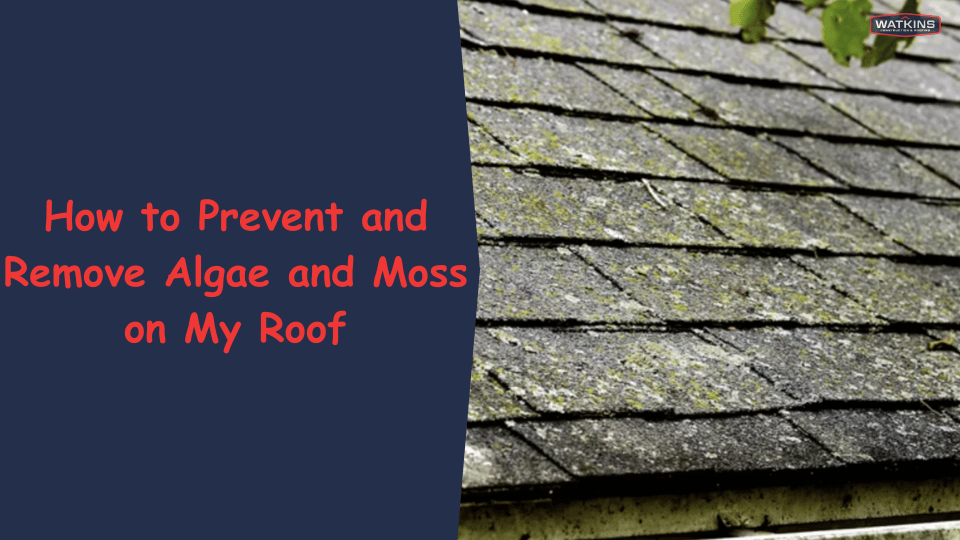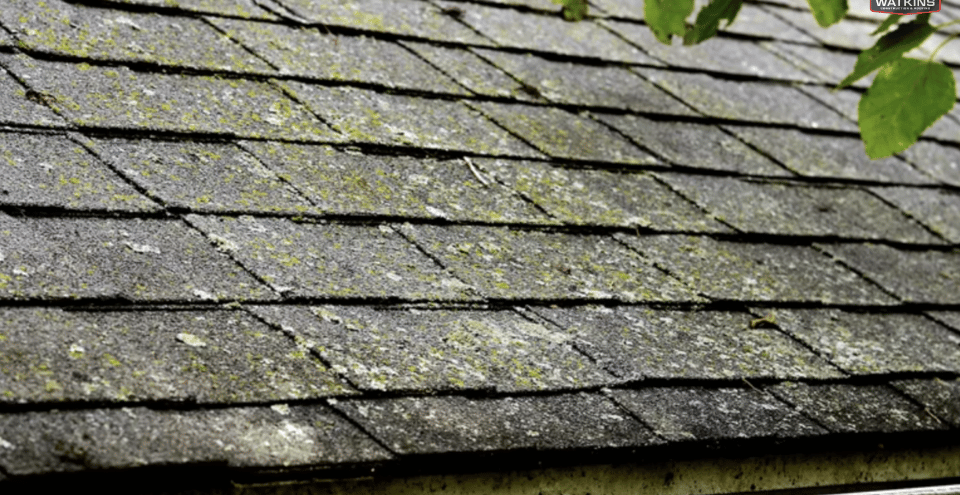How to Prevent and Remove Algae and Moss on My Roof with Watkins Construction & Roofing. Your roof is your home’s first line of defense against the elements, and its health is crucial for maintaining the overall integrity of your property. Over time, however, roofs can fall victim to various issues, including the growth of algae and moss. While these organisms may seem harmless at first, they can cause significant damage to your roof if left unchecked. In this guide, we’ll explore the causes, prevention, and removal of algae and moss on your roof to help you keep your home’s roofing system in optimal condition.

Understanding Algae and Moss on Roofs:
Algae: Algae are simple, green or black microorganisms that thrive in damp, shaded areas. They usually appear as green or dark streaks on your roof’s surface. The most common type of algae found on roofs is known as Gloeocapsa magma. Algae growth is most prevalent in regions with high humidity levels.
Moss: Moss is a more complex plant-like organism that can grow on your roof, especially in areas with cool, damp conditions. Mosses have small, leafy structures and can create a lush, green carpet-like appearance on your roof.
Causes of Algae and Moss Growth:
Several factors contribute to the growth of algae and moss on your roof:
Shaded Areas: Algae and moss thrive in areas with limited sunlight. Shaded sections of your roof are more susceptible to their growth.
Moisture: Damp and humid conditions provide an ideal environment for these organisms to flourish. Rainfall, dew, or poor drainage can create moisture on your roof’s surface.
Organic Debris: Leaves, twigs, and other organic debris that accumulate on your roof can provide a substrate for algae and moss growth.
Tree Overhangs: Overhanging branches and tree debris can contribute to the shading and moisture retention that promotes algae and moss.
The Impact of Algae and Moss on Your Roof:
The presence of algae and moss on your roof can lead to several problems:
Aesthetics: Algae and moss growth can detract from your home’s curb appeal, making it look unkempt and poorly maintained.
Reduced Lifespan: These organisms can accelerate the deterioration of roofing materials, potentially shortening the lifespan of your roof.
Water Retention: Moss can trap moisture on your roof’s surface, which can lead to water damage and rot in the underlying materials.
Weakened Shingles: Moss can lift roofing shingles, making them more susceptible to wind damage.
Preventing Algae and Moss Growth:
Prevention is the key to keeping algae and moss at bay. Here are some preventive measures:
Trim Overhanging Branches: Prune trees near your roof to allow more sunlight and airflow, reducing shaded areas.
Clean Gutters: Keep your gutters free of debris to prevent water from accumulating on your roof.
Install Zinc or Copper Strips: Metal strips made of zinc or copper can be placed near the ridge of your roof. When it rains, these metals release ions that inhibit algae and moss growth.
Regular Roof Maintenance: Schedule regular roof inspections and cleanings by a professional roofing contractor. They can identify and address early signs of algae or moss growth.
Apply Algae-Resistant Shingles: Some roofing manufacturers offer shingles treated with algae-resistant coatings that can deter algae growth.
Removing Algae and Moss:
If you already have algae or moss on your roof, here’s how to safely remove them:
Safety Precautions: Ensure you have proper safety equipment, including a safety harness, non-slip shoes, and safety goggles, before attempting any roof work.
Gentle Cleaning: Use a low-pressure garden hose or a soft-bristle brush to gently scrub away algae or moss. Avoid using high-pressure washers, as they can damage shingles.
Chemical Treatments: Roofing professionals can apply specialized chemical treatments to kill and remove algae and moss. This should only be done by experienced contractors to prevent damage to your roof.
Preventive Maintenance: After removal, consider preventive measures such as zinc or copper strips to deter future growth.
DIY vs. Professional: While DIY cleaning is possible, it’s safer and more effective to hire a professional roofing contractor for algae and moss removal, especially if the growth is extensive.
In conclusion, algae and moss can compromise the appearance and integrity of your roof if left untreated. Regular roof maintenance, preventive measures, and professional cleaning can help protect your roof from these invasive organisms. By addressing the issue promptly, you can extend the lifespan of your roof and keep your home looking its best. If you’re unsure about the best course of action, consult with a roofing professional to assess the condition of your roof and recommend the most appropriate treatment.
For more information, you can reach Watkins Construction & Roofing at 601-488-3179. We service areas in Jackson, Flowood, Clinton, and Ridgeland, MS.
